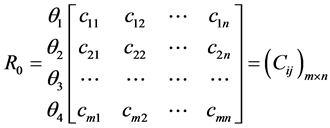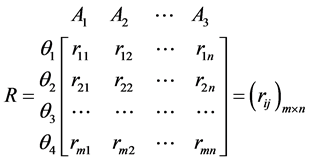1. 引言
鄱阳湖是中国最大的淡水湖,被有关专家称为“仅剩的一盆清水”。近年来鄱阳湖水环境质量状况呈下降趋势,引起了各级领导和社会各界的高度关注。温家宝总理批示要“维护鄱阳湖一湖清水”。水利部要求把“确保鄱阳湖一湖清水下泄”作为江西水利工作的战略制高点。按照江西省委省政府提出的“既要金山银山,更要绿水清山”、“建设绿色生态江西”和“建设鄱阳湖生态经济区”的发展要求,江西省水利部门于2007年9月,正式启动了鄱阳湖水资源动态监测工作,为政府决策提供科学依据。
鄱阳湖水资源动态监测在湖区共布设了19个监测断面以及14个水环境典型调查点。工作开展两年多所累计的监测数据具备了一定的条件对布设的站点进行水质监测站点的优化布设分析。如将监测点的布设进行优化后,仍然能够比较完整和客观地反映整个水域的水质状况,就能提高监测工作效率,并减少大量的人力、物力、财力。从国内近10年相关文献检索情况看,环境质量监测点优化布设的方法较多,如模糊聚类法、物元分析法、密切值法、贴近度法等[1] -[3] 。本文采用贴近度法[4] ,对鄱阳湖水资源动态监测站点进行优化分析,应用监测数据域水质标准之间贴近度的概念,并根据贴近度的大小对监测点进行科学合理的聚类,再从每类中选择代表点位,最后实现布点优化的目标。该方法概念明确、计算简便、形象直观、结论唯一等特点,适用于鄱阳湖水资源动态监测的站点优化。
2. 建模原理与计算步骤
2.1. 建模原理
湖泊水环境是一个较为复杂的系统,如何将多指标的监测参数转化为能综合反映水质质量情况的单指标参数,进而根据该单指标参数进行监测点聚类,这是监测点优化的基本途径,也是贴近度概念的提出与应用的出发点。贴近度法优化的基本过程是:找出各监测点多指标参数中每个指标监测值的最大或最小值,将这些单指标的最大值或最小值合成为一个虚拟的“最优值”或“最差值”求出各监测点及标准值点与“最优值”或“最差值”的距离,并据此计算各测点与标准值点的贴近程度(贴近度),由贴近度来对各监测点进行聚类,根据聚类结果最终实现优化布点的目标。
2.2. 计算步骤
建立样本矩阵,构建虚拟的“最优点”或“最差点”
将 个监测点
个监测点 及一个标准值点
及一个标准值点 的
的 个评价指标
个评价指标 ,构成初始矩阵R0:
,构成初始矩阵R0:
 (1)
(1)
其中: 是第
是第 个监测点
个监测点 的第
的第 个评价指标的量化值,
个评价指标的量化值, ,
,  ,
, 是标准值的第
是标准值的第 个指标值,
个指标值, 。令
。令
 (2)
(2)
将矩阵(1)进行归一化处理,建立样本矩阵 :
:
 (3)
(3)
式中:
 为待优化的样本点。
为待优化的样本点。
由于水质指标为负向指标,指标值越大,水质越差。即样本综合后的最优点应为各指标的最小值集合点,最劣点则为各指标的最大值集合点,即最优点:
 (4)
(4)
最劣点:
 (5)
(5)
2.3. 计算各样本点距“最优点”、“最劣点”的距离
最优点 、最劣点
、最劣点 为鄱阳湖水质污染极端状况(最好、最差)的虚拟点。求出各个样本点及标准值点与该两虚拟点之间的距离,再根据它们距离计算出各样本点与标准值点的贴近度,即可为各水质监测点的优化提供定量计算判断的依据。
为鄱阳湖水质污染极端状况(最好、最差)的虚拟点。求出各个样本点及标准值点与该两虚拟点之间的距离,再根据它们距离计算出各样本点与标准值点的贴近度,即可为各水质监测点的优化提供定量计算判断的依据。
我们定义第 个样本点与“最优点”的距离为:
个样本点与“最优点”的距离为:
 (6)
(6)
定义第 个样本点与最差点的距离为:
个样本点与最差点的距离为:
 (7)
(7)
同理可定义标准值点与“最优点”及“最差点”的距离为:


式中: 为第
为第 个指标(即第
个指标(即第 个污染物因子)在整个水质评价中的权重。湖区水质主要污染因子:溶解氧、氨氮、高锰酸盐指数、总磷在湖区水质质量评价中的地位是相同的,作用也是相同的,故选
个污染物因子)在整个水质评价中的权重。湖区水质主要污染因子:溶解氧、氨氮、高锰酸盐指数、总磷在湖区水质质量评价中的地位是相同的,作用也是相同的,故选
 。
。
2.4. 计算各样本点与标准值点的贴近度
因最优点、最劣点及各样本点并不位于一条直线上(多因素系统可视为欧氏空间),一个样本点离 点越近,
点越近, 越小,但并不意味着
越小,但并不意味着 就越大。同理
就越大。同理 越小,但并不意味着
越小,但并不意味着 就越大。因此单纯地以
就越大。因此单纯地以 、
、 作为优化的依据,有可能出现相互矛盾的结果,从而必须进一步引进可综合反映两者之间关系的数值,也就是对它们进行进一步地归一化处理。各样本点与标准值点之间的贴近度正好满足这个需求。定义第
作为优化的依据,有可能出现相互矛盾的结果,从而必须进一步引进可综合反映两者之间关系的数值,也就是对它们进行进一步地归一化处理。各样本点与标准值点之间的贴近度正好满足这个需求。定义第 个样本点与标准值点m的贴近度为:
个样本点与标准值点m的贴近度为:
 (8)
(8)
则水环境质量评价中的多个指标 ,就可以转化为能从总体上衡量水环境质量优劣的单指标
,就可以转化为能从总体上衡量水环境质量优劣的单指标 ,。对待评价的样本点i而言,
,。对待评价的样本点i而言, 越接近于1,
越接近于1, 点水质质量越接近于标准值点的水质质量。
点水质质量越接近于标准值点的水质质量。 大于1,表示
大于1,表示 点水质质量总体上好于标准值点的水质质量,
点水质质量总体上好于标准值点的水质质量, 越大,质量越好。小于1,表示
越大,质量越好。小于1,表示 点水质质量总体上比标准值点的水质质量差。
点水质质量总体上比标准值点的水质质量差。 越小,质量越差。从小到大排序,同一级次的点位可视为水质质量水平相近,并可聚为一类,在每一类中选择有代表性的点位作为优化点,即可完成监测点优化的目标。
越小,质量越差。从小到大排序,同一级次的点位可视为水质质量水平相近,并可聚为一类,在每一类中选择有代表性的点位作为优化点,即可完成监测点优化的目标。
3. 实例计算
3.1. 鄱阳湖水质动态监测点贴近度分析
鄱阳湖具有吞吐量大的特点,水位变化大,湖区水面面积和水体容积具有很大变幅。结合水质水量数据来看,湖区水位的高低影响着水质的好坏,水质在高水位和低水位时存在明显的差异,水位高时湖区水面面积和水体容积相应较高,湖体纳污能力及自净能力较强,湖区水质整体较好,III类以上水质类别比重远高于III类以下水质类别比重。根据这个特征,将鄱阳湖水环境监测中心2008年1月至2009年10月的监测资料结合鄱阳湖水位,应用贴近度法,分别对低于14 m (每月采样期间星子站平均水位)和高于14 m的两种情况的湖区19个监测断面进行优化,表1所示,表中加了一个标准值点(GB3838-2002《地表水环境质量标准》中III类水质的标准)。所选用的污染因子有4个,分别是溶解氧、氨氮、高锰酸盐指数、总磷。
根据贴近度的计算方法,我们首先建立19个监测点数据及一个标准值点数据的样本矩阵 ,将矩阵进行归一化处理得到无量纲
,将矩阵进行归一化处理得到无量纲 ,并求出各样本点及标准值点与最优点最劣点,再运用式(6)与(7),求出各样本点及标准值点与最优点最劣点的距离。
,并求出各样本点及标准值点与最优点最劣点,再运用式(6)与(7),求出各样本点及标准值点与最优点最劣点的距离。
从表2中可以看出 大的点
大的点 并不一定就小,同理
并不一定就小,同理 大的点
大的点 并不一定就小,因此各样本点与最优点、最劣点的距离
并不一定就小,因此各样本点与最优点、最劣点的距离 、
、 只能作为各测点水质质量水平的参考依据,要最后确定水质质量的聚类与优化,还必须最后根据式(8)计算样本点与标准值点的贴近度
只能作为各测点水质质量水平的参考依据,要最后确定水质质量的聚类与优化,还必须最后根据式(8)计算样本点与标准值点的贴近度 ,表3所示。
,表3所示。
从表3可以看出:在水位低于14 m时,乐安河口水质相对较差,贴近度小于标准值(III类水),鄱阳监测点受乐安河来水来污的影响,贴近度也小于标准值,鄱阳湖湖区其余各监测点水质状况良好,贴近

Table 1. The water quality data of monitoring points in the Poyang Lake
表1. 鄱阳湖监测点水质数据


Table 2. Distances between monitoring points and the best and the most inferior point
表2. 监测点与最优点最劣点的距离

Table 3. The approach degree of monitoring points and the standardized value points
表3. 监测点与标准值点间的贴近度
度均大于标准值。在水位高于14 m时,各监测站点水质状况的贴近度均大于标准值,水质明显好于水位低于14 m的状况。因此我们认为,在枯水季节和丰水季节,因水文因素的差别导致来水来污方式有差异,是枯水期和丰水期结果有差别的重要原因。
3.2. 贴近度法鄱阳湖水质动态监测点优化
结合贴近度计算结果以及鄱阳湖来水来污特点,将鄱阳湖分为东、南、西、北、中五个部分。东部区域为昌江口、乐安河口、信江东支口及水质受其影响较大的鄱阳监测点;南部区域为赣江南支口、抚河口、信江西支及水质受其影响较大的康山监测点;西部区域为赣江主支口、修河口、蚌湖、渚溪口监测点;北部区域为主要通江航道内布设的星子、蛤蟆石、湖口监测点;中部区域为深入鄱阳湖腹地的龙口、瓢山、棠荫、都昌监测点。
3.2.1. 贴近度法东部区域监测点优化
东部区域昌江口水质相对较好,可以适当减少监测频次。信江东支与位于西部区域的信江西支同起于信江,因受上游磷矿的影响,TP含量偏高,在水位低于14 m时,两者贴近度较好,水位高于14 m时,两者贴近度稍有差别但水质相对较好,结合采样过程中的实际情况,将信江东支监测点进行优化处理。因鄱阳水质特点主要受乐安河来水影响较大,乐安河口与鄱阳监测点贴近度相似,结合地理位置考虑,鄱阳监测点水质状况更能体现湖盆水质特点,故将乐安河口监测点进行优化处理。
3.2.2. 贴近度法南部区域监测点优化
南部区域抚河口监测点因水质相对较好,可以适当减少监测频次。康山与赣江南支监测点位置接近,而康山监测点更能反映湖盆水质特点,故将赣江南支点进行优化处理。信江西支保持原有监测频次。
3.2.3. 贴近度法西部区域监测点优化
西部区域修河口因受上游柘林水库来水的影响,水质相对较好,可以适当减少监测频次。渚溪口水质主要受修河口、赣江主支、都昌来水影响,根据贴近度分析,水位低于14 m时渚溪口与都昌可以聚为一类,在水位高于14 m时渚溪口与蚌湖可以聚为一类,并考虑到监测点位置布设,将渚溪口进行优化处理。赣江主支与蚌湖保持原有监测频次。
3.2.4. 贴近度法北部区域监测点优化
渚溪口至湖口为北部入江航道,考虑到距离较长,且布点不多,保留星子、蛤蟆石、湖口三个监测点原有监测频次。
3.2.5. 贴近度法中部区域监测点优化
棠荫和瓢山地理位置接近,同处湖泊中央。水位低于14 m时,因水位降低,导致来水来污的差别,两点水质差别较大,而在高水位时,因湖泊水位较高、湖面宽广,水质相似,根据贴近度将两点聚类。同时因棠荫相对更具有代表性,故在水位高于14 m时将瓢山进行优化处理。龙口与都昌保持原有监测频次。
3.3. 贴近度法鄱阳湖水质动态监测点优化结果检验
根据以上分析,水位低于14 m时,我们将昌江口、乐安河口、信江东支、抚河口、赣江南支、修河口、渚溪口进行了优化处理,优化后的剩余站点为鄱阳、龙口、瓢山、康山、信江西支、棠荫、都昌、蚌湖、赣江主支、星子、蛤蟆石、湖口,共12个站点。
水位高于14 m时,除了以上站点外,还对瓢山监测点进行了优化处理,优化后的剩余站点为鄱阳、

Table 4. Mean values before and after optimization
表4. 优化前后的均值
龙口、康山、抚河口、信江西支、棠荫、都昌、蚌湖、赣江主支、星子、蛤蟆石、湖口,共11个站点。
优化结果检验如下:将湖区优化前后两种布点方法获得的水质监测数据进行平均值的统计检验。我们对表4中优化前后的数据进行均值检验,其中优化前(n = 19)优化后(枯水期n = 12,丰水期n = 11)各污染因子的均值见表4。
经均值检验,优化前后各项目无明显差异,表明优化结果是正确的。
4. 结论
贴近度法是一种多目标优化方法,它可以聚类也可以排序。应用实例表明,贴近度法能很直观地表明鄱阳湖水质状况及空间变化,同时还表明将其应用于鄱阳湖水资源动态监测布点优化时成功的,优化结果可以接受。贴近度法计算意义明确、概念清楚、灵活简便,是一种较好的数据处理方法。
本文限于篇幅,仅将水位分为低于14 m及高于14 m两个层次进行分析计算,在实际工作中,还可以根据鄱阳湖的水位变化特点,进行更精确的分类计算。

NOTES
作者简介:李梅(1977-),女,工程师,主要从事水生态监测研究、水资源调查评价工作。